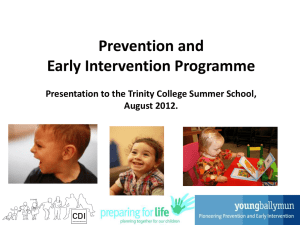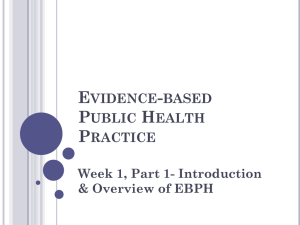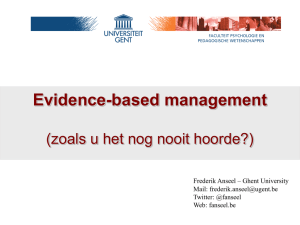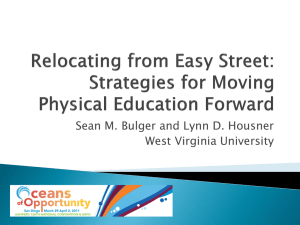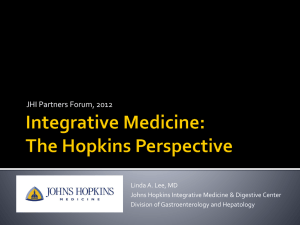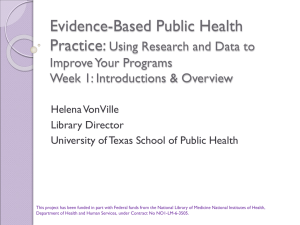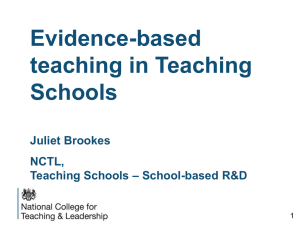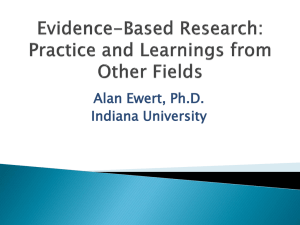Disease Prevention and Health Promotion Services (OAA Title IIID)
advertisement
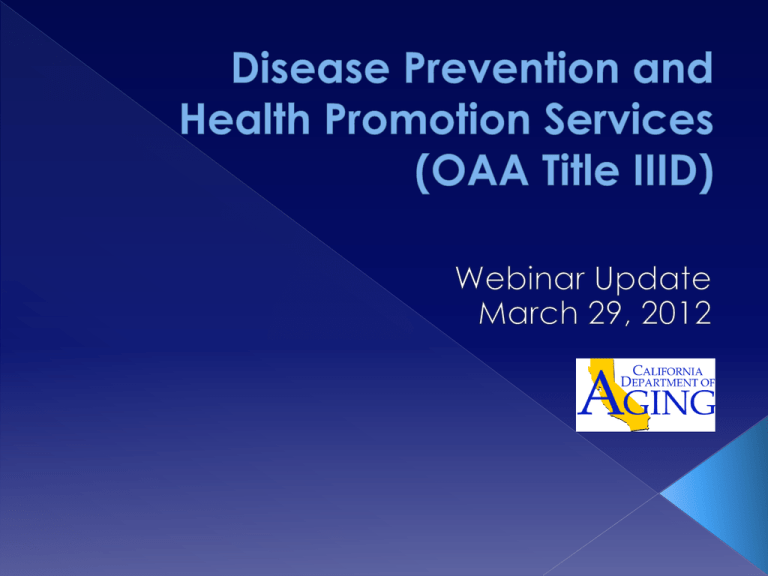
In the 2006 reauthorization of the Older Americans Act (OAA) language was added to encourage the use of evidencebased health promotion programs. [OAA Sec. 102.(a)(14)] The FY 2012 Congressional appropriations now require that Older Americans Act Title IIID funding is used only for programs and activities which have been demonstrated to be evidence-based. The Administration on Aging has developed a graduated set (three tiers) of criteria for defining evidence-based interventions. Health promotion programs can fall within any of the three tiers. Each AAA will assess their programs based on the three tier criteria. While the goal is for all Title IIID activities to move toward the highest-level criteria, programs meeting the minimal or intermediate criteria will meet the FY-2012 requirements. Demonstrated through evaluation to be effective for improving the health and wellbeing or reducing disease, disability and/or injury among older adults; and Ready for translation, implementation and/or broad dissemination by community-based organizations using appropriately credentialed practitioners. Programs related to the prevention and reduction of the effects of chronic disease including: Healthy Eating for Successful Living http://www.healthlyagingporgams.com/cont ent.asp?aectionid=30&ElementID=206 Health screening by registered nurses Nutrition counseling and education by registered dietitians Medication review by pharmacists Yoga Classes by certified Yoga instructor Maintain supporting documentation: Evaluate effectiveness 1. Peer reviewed journal articles 2. Dissemination products 3. Evidence such a pre/post tests Credentials of practitioner’s certification 1. Copy of practitioner license 2. Information on screening 3. Faculty letter/email 4. Transcripts/minimum job requirements Intermediate Criteria Published in a peer-review journal. Proven effective with older adult population, using some form of a control condition (e.g. pre-post study, case control design, etc.). Some basis in translation for implementation by community level organization. Eat Better Move More › http://www2.fiu.edu/~nutreldr/STEPS_Progra m/Moving_More/Eating_Better_Moving_Mor e.htm Undergone Experimental or QuasiExperimental Design Level at which full translation has occurred in a community site. Level at which dissemination products have been developed and are available to the public. Active Living Every Day; A Matter of Balance; Chronic Disease Self-Management Program; Enhance Fitness Walk with Ease (information available on Webinar: April 19, 2012 10:00-11:00) The new requirements apply to Fiscal Year (FY) 2012 funds. Contracts made with previous funds do not have to be altered. Multi-year contracts which began prior to FY-2012 may have to be altered depending on whether the contracts include activities that meet at least the minimal criteria for evidence-based Title IIID programs. The FY 2012-2016 Area Plan that AAA are currently developing will not be required to be changed prior to the May 2012 submission. However, if the Area Plan includes Title IIID activities that do not meet the minimal criteria for evidence-based programs then an Area Plan Update with activities that meet the minimal AoA criteria must be submitted later this year. Future guidance to follow. The reporting requirements for Title IIID have not changed. Data dictionary will be updated Medication Management (MM) will no longer be required as a separate service category; however, MM is an allowable service activity as part of the Title IIID services. Report MM activities as a Title IIID activity Following this webinar CDA survey will distribute a survey for AAAs to: Evaluate the criteria level of the programs provided by the AAA. A pdf version will go out for you as a worksheet. If you are have questions please call Beth Sloane. 1. How does the Older Americans Act (OAA) define evidence-based? A description of evidence-based: demonstrated through rigorous evaluation to be evidence-based and effective. 2. How does AoA define evidence-based? AoA liberalized the definition to the include many programs that have minimal evidence base but encourage movement towards the highest criteria. 3. Do exercise programs meet the criteria for evidence-based programs? Not all do. Others will depend on the AAA’s requirement such as credentialed practitioner to qualify and an evaluation of effectiveness. AAA may set the criteria for evaluation and certification. 4. Can AAA afford to implement evidencebased programs given limited funded? There are free and low cost programs available. Partnerships and collaboration are another way to provide programs such as Walk with Ease. 5. Why are evidence-based initiatives in preventative health important? Evidence -based programs effectively promote the adoption of healthy lifestyle behaviors, which reduce healthcare costs. 6. Are there new reporting requirements to reflect the evidence-based requirements.? No, there are no new reporting requirements. Medication Management will no longer be required as a separate service category. Medication Management is an allowable service activity as part of Title IIID services. 7. Are Title IIID funds able to be used for Chronic Disease Self Management Program (CDSMP)? Yes, it is allowed. 8. What would need to be done to ensure a program meets the criteria for an allowable Title IIID expenditure? Minimum criteria are evaluation and having a credentialed practitioner. AAA decides to evaluate the program to demonstrate effectiveness improving health behaviors, improving knowledge, or reducing the risk of chronic disease. 8. continued Does the program have a foundation in research, or participant evaluations that indicate your program leads to improved health behaviors? Does the program require an appropriately credentialed practitioner? 9. Would a health fair qualify as evidencebased? Some activities qualify: health screenings, programs provided by appropriately credentialed staff and activities approved by the AAA. Some activities that do not qualify are sports competitions, health information booths, and demonstrations. 10. What funding can be used to support health fair activities that do not qualify as evidence-based? Other funding must be used such as OAA Title IIIB funding for community education. or volunteers from the community that provide health fair activity free of charge. 11. Do grantees have to provide activities that meet the highest criteria? No. Move your programs towards the highest criteria as possible. Meet the minimum the criteria. 12. In order to meet the highest-level criteria does my health promotion first have to meet the other two criteria? Yes, the process is a stepwise transition. 13. Can Title IIID evidence-based funding be used for Care Transitions? Yes, many evidence-based programs support Care Transitions: Medication Management, CDSMP, health assessment, health/nutrition education and counseling. 14. For interventions that fall into the minimal and intermediate criteria what, if any, supporting documentation should SUAs or AAAs provide to substantiate that they are meeting the new Title IIID requirements? None. The AAA will want to retain documentation of the evidence behind their chosen Title IIID program for their own records. CDA will provide a survey for AAA to identify the criteria met by their programs. Beth Sloane MPH, RD Public Health Nutrition Consultant II 916.928.7890 beth.sloane@aging.ca.gov
